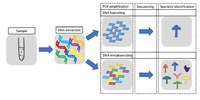
Trophic ecology of tadpoles in floodplain wetlands: combining gut contents, selectivity, and stable isotopes to study feeding segregation of syntopic species
Sign Up to like & getrecommendations! Published in 2020 at "Hydrobiologia"
DOI: 10.1007/s10750-020-04303-0
Abstract: Little consensus exists on the role of food partitioning in the organization of tadpole assemblages. We studied trophic ecology of syntopic tadpoles through the analysis of gut contents, selectivity, and stable isotopes to assess the… read more here.
Keywords: stable isotopes; gut contents; trophic ecology; food ... See more keywords

Fast molecular assay to detect the rate of decay of Bactrocera oleae (Diptera: Tephritidae) DNA in Pterostichus melas (Coleoptera: Carabidae) gut contents
Sign Up to like & getrecommendations! Published in 2018 at "Applied Entomology and Zoology"
DOI: 10.1007/s13355-018-0564-x
Abstract: The molecular analysis of predation through specific DNA amplification has been utilized extensively over the last decade, and has been shown to be fast and effective. However, it is necessary to evaluate the prey detectability… read more here.
Keywords: gut contents; bactrocera oleae; pterostichus melas; dna ... See more keywords

The first corydalid larva (Megaloptera: Corydalidae) with gut-contents from the Early Cretaceous Jehol biota of northeastern China
Sign Up to like & getrecommendations! Published in 2019 at "Cretaceous Research"
DOI: 10.1016/j.cretres.2019.03.015
Abstract: Abstract The fossil record of the family Corydalidae (Megaloptera) is rare with only six reported species and several undescribed larvae from the Middle Jurassic to Eocene. Little is known about the food habits and digestive… read more here.
Keywords: corydalid larva; gut contents; megaloptera; first corydalid ... See more keywords

Differential Engagement of Fermentative Taxa in Gut Contents of the Earthworm Lumbricus terrestris
Sign Up to like & getrecommendations! Published in 2017 at "Applied and Environmental Microbiology"
DOI: 10.1128/aem.01851-17
Abstract: ABSTRACT The earthworm gut is an anoxic, saccharide-rich microzone in aerated soils. The apparent degradation of diverse saccharides in the alimentary canal of the model earthworm Lumbricus terrestris is concomitant with the production of diverse… read more here.
Keywords: lumbricus terrestris; gut associated; gut; earthworm lumbricus ... See more keywords

Gut contents of larval fishes from Iight trap and plankton net collections at Enmedio Reef near Veracruz, Mexico
Sign Up to like & getrecommendations! Published in 2017 at "Revista De Biologia Tropical"
DOI: 10.15517/rbt.v41i1.29290
Abstract: Traditionally, it has been assumed that reef fish recruitment is a density dependent process determined by adult population size and resource limitations (Sale 1978). More recent ideas on factors regulating population size include the concept… read more here.
Keywords: reef; gut contents; plankton; fish larvae ... See more keywords

Frequency of Microplastics in Mesopelagic Fishes from the Northwest Atlantic
Sign Up to like & getrecommendations! Published in 2018 at "Frontiers in Marine Science"
DOI: 10.3389/fmars.2018.00039
Abstract: Microplastics are a ubiquitous pollutant in our seas today and are known to have detrimental effects on a variety of organisms. Over the past decade numerous studies have documented microplastic ingestion by marine species with… read more here.
Keywords: mesopelagic fish; northwest atlantic; gut contents; microplastics mesopelagic ... See more keywords

Profiling Analysis of Filter Feeder Polypedilum (Chironomidae) Gut Contents Using eDNA Metabarcoding Following Contrasting Habitat Types—Weir and Stream
Sign Up to like & getrecommendations! Published in 2022 at "International Journal of Environmental Research and Public Health"
DOI: 10.3390/ijerph191710945
Abstract: We analyzed the dietary composition of Polypedilum larvae among two contrasting habitats (river and weir). Our approach was (i) to apply eDNA-based sampling to reveal the gut content of the chironomid larvae, (ii) the diversity… read more here.
Keywords: gut; using edna; food; gut contents ... See more keywords